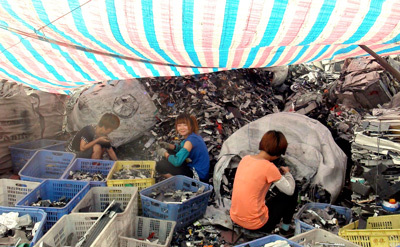NWPSC May 2015 Newsletter
King County, Washington sent this bulletin at 05/15/2015 03:09 PM PDT

May 2015
Electronic Waste in the News
The Children Who Make a Living in the Toxic World of Discarded Electronics
After photographer Valentino Bellini visited Agbogbloshie, Ghana, "the world's largest e-waste dumping site," he created a photo-documentary website – the Bit Rot Project – with graphic images of the impacts of discarded electronics. "It was like hell...The air was heavy from burning plastic" Bellini told the Washington Post in an April 15, 2015 article.
5 Ways to Get People to Recycle More Electronics
"#5: Get the manufacturer involved ...more and more products are being designed in a way that is harder to recycle. They are harder to take apart and the stuff electronics are made of is less valuable." Despite states' e-recycling laws, electronics are the fastest-growing type of waste in landfills—Governing magazine March 2015.

Photos of imported electronics in China courtesy of the Basel Action Network

The Dark Side of the Digital Age: E-Waste
A Huffington Post article cites findings from the United Nations University (UNU) Global E-Waste Monitor 2014 report.
Globally we produced 41.8 million tonnes of e-waste in 2014 and less than one-sixth is properly recycled or reused. Most e-waste from developed countries is exported to developing countries like India, Africa and China, where improperly performed recovery methods like acid baths and burning of electronics are extremely harmful and often done by local women and children. The lack of proper recycling leads to lead and mercury leaching into the environment. While it is legal to ship waste to developing nations, some of the waste is exported illegally under the guise of "used goods" instead, which has less regulations. The UNU report estimates there is $52 billion in discarded reusable resources like iron, copper, gold, silver.
Programs and Resources
Children's Car Seats – Ripe for Producer Responsibility?
An April 2015 report (PDF) from Old Car Seat, New Life (Zero Waste Washington and CoolMom), details the status of car seat collection and recycling and the challenges existing efforts are encountering, both in the Puget Sound area and nationally. The use of car seats is mandated by laws in every state, from birth "through the age of eight or until they reach 4'9" in height." In King County, Washington, alone, "the 27,032 babies that were born in 2012 will each use two or three car seats during the course of their childhoods." An estimated 10 million car seats are sold each year in the U.S.; at an average weight of about 15lbs., "the lack of recycling options results in an estimated 150 million pounds of plastic and metal making their way into landfills or incinerators annually in the United States." The report and a car seat collection locator for the U.S., and Alberta and British Columbia, Canada, can be found on their website: RecycleYourCarSeat.org
How2Recycle 2014 Annual Report
How2Recycle, a project of GreenBlue's Sustainable Packaging Coalition, released its 2014 annual report (PDF). The How2Recycle Label is a "standardized labeling system that clearly communicates recycling instructions to the public. Variation in recycling programs, unclear labeling, and inaccurate recyclability claims make proper recycling a challenge. The How2Recycle Label was created to provide consistent and transparent on-package recycling information to consumers. Currently the label only applies to packaging sold in the U.S., with a few select labels available for packaging sold in Canada."
First Mattress Stewardship Program Began May 1 in Connecticut
The Mattress Recycling Council (MRC), the nonprofit stewardship organization established by the mattress industry, developed and is managing the Connecticut Mattress Stewardship Program, which has been named Bye Bye Mattress, to collect and recycle mattresses and box springs discarded in Connecticut. The program is funded through a $9 visible recycling fee collected at retail from customers on each mattress and box spring sold in the state. The MRC will launch similar programs in California and Rhode Island in 2016.
Upcoming Events
- Washington State Recycling Association (WSRA) Annual Conference: May 17-20, Spokane, WA
- Advanced Paint Stewardship (webinar): May 21, 11am-12:30pm Pacific
- Sustainable Oregon 2015: June 3-5, Riverhouse, Bend, OR
- Tour Recycling Processing Facility: June 23, Tacoma, WA
PAC NEXT and Waste Management are sponsoring a tour of and networking lunch at JMK Fibers on June 23 (there is a $30 fee to cover costs, including lunch). JMK Fibers handles recyclables from single stream curbside collection and other materials from throughout the region. PAC NEXT, an initiative of PAC - Packaging Consortium, envisions "A World Without Packaging Waste." Those interested in packaging design and recyclability are invited to attend. Visit PAC NEXT to register and find more information.
 The Northwest Product Stewardship Council (NWPSC) is a coalition of government agencies in Washington and Oregon working on solid waste, recycling, resource conservation, environmental protection, public health and other issues. Together with non-government agencies, businesses and individuals, we form a network that supports product stewardship and extended producer responsibility (EPR) policies and programs. For more information, contact info@productstewardship.net or visit us at www.ProductStewardship.net.
The Northwest Product Stewardship Council (NWPSC) is a coalition of government agencies in Washington and Oregon working on solid waste, recycling, resource conservation, environmental protection, public health and other issues. Together with non-government agencies, businesses and individuals, we form a network that supports product stewardship and extended producer responsibility (EPR) policies and programs. For more information, contact info@productstewardship.net or visit us at www.ProductStewardship.net.
Subscribe to the NWPSC Newsletter. For current subscribers: update your email, password, or unsubscribe on the Subscriber Preferences Page (you will need to use your email address to log in). If you have questions or problems with the subscription service, please visit subscriberhelp.govdelivery.com.